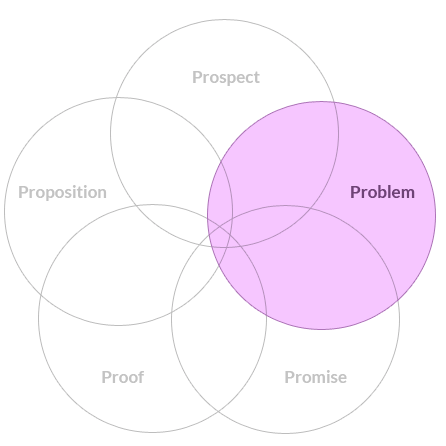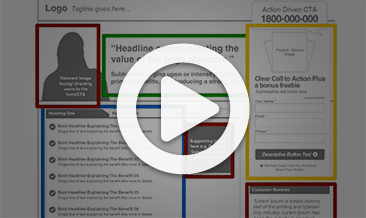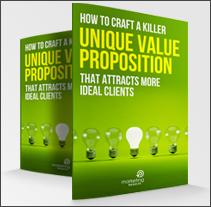[Infographic] How To Create An Effective Unique Value Proposition

A step-by-step process for attracting, converting and monetising the most profitable customers in your market.
Let’s start with a simple premise: all customers are not created equal.
Some are dramatically more profitable than others. Some are in a position to extract maximum value out of your products or services. Some you want to have as customers or clients – others you may wish to avoid like the plague.
You don’t just need “more customers”. You need better quality customers.
I recall an economics lecture at university, where the definition of economics involved the word “scarcity”. And in fact here’s a definition from a modern economics textbook:
Economics is the study of choices consumers, business managers, and government officials make to attain their goals, given their scarce resources.
That definition may have sufficed in the late 20th century, but the world has moved on. In a growing number of categories, supply of products and services is growing dramatically, while demand is flattening or even contracting.
Basic needs are largely met. And the key to profitability is supplying what your most profitable customer segments WANT, not just what they NEED.
Online, hardly any companies get this. They market to anyone capable of punching in a search term. Drilling down to a deeper level of thinking represents a golden opportunity for you.
Here’s the impact more “AA-grade” customers would have on your business.
Using 80/20 thinking, the top 20% of the potential customers in any market are “A-grade”. And around 4% (= 20% x 20%) are “AA-grade”:

80/20 logic also implies that “A-grade” clients spend 80% of all the money in your market,
and “AA-grade” clients spend 64% of the money (= 80% x 80%):
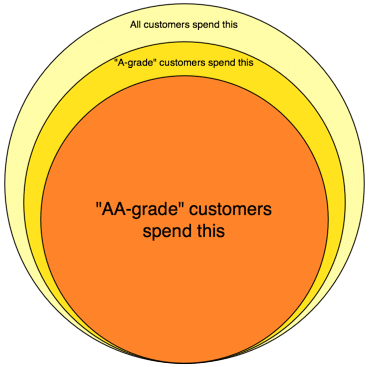
The contrast could hardly be more stark:
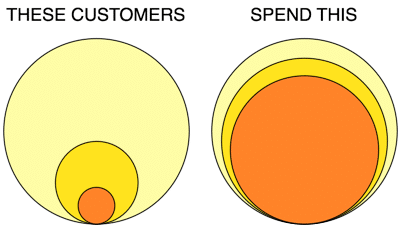
You don’t have to follow the math. The important thing to note is that a small handful of prospects in any market spend the vast majority of the money.
When you look at it this way, you’re not so much trying to reach everyone in your target market, as you are trying to preferentially target your “AA-grade” prospects.
“Ideal Client Attraction” vs Traditional Online Marketing
Back when clicks were cheap and SEO competition was weak, online marketing was a lot easier. Generating leads and sales was inexpensive, and if a portion of your marketing budget was wasted, so what? It was still profitable.
Today, the landscape has shifted. Clicks are more expensive. Buyers are more informed. SEO competition is more robust. Good content is free, plentiful and noisy. And in a growing number of industries, being “good” is not good enough.
Incremental improvement is no longer the answer.
Incremental improvement will only make you “good-er” than the competition.
But if you want to make the competition irrelevant, a paradigm shift is needed.
| Traditional Online Marketing | Ideal Client Attraction | |
|---|---|---|
| Traffic | Any click is a good click | Cherry-pick ideal clicks |
| Benefits | Price-of-entry benefits | Point-of-difference benefits |
| Targeting | Demographics and segments | Psychographics and micro-segments |
| LeadS | Lead volume | Ideal lead volume |
| Focus | Efficiency: doing things right | Effectiveness: doing the right things |
| Time Horizon | Quick runs on the board | Sustainable market dominance |
| Market Position | Commodity to Premium | Premium to Unique |
| Customer Metric | Cost of Acquisition | Life Time Value |
If you recognise the desperate need to attract more, higher quality leads and clients via the web, the next question becomes HOW to do it.
Here’s the thinking framework we have developed to accomplish this:
Introducing The Conversion Kaleidoscope
The Conversion Kaleidoscope is a framework for attracting, converting and monetising the most profitable clients in any market.

Here’s an overview of the 5 “Lenses” that make up the Conversion Kaleidoscope and how they fit together. We drill down into each Lens in much more depth during 1-day StrategySessions and client engagements, but at this stage we’ll look at a 10,000-foot view:
Lens #1 is Prospect:

More specifically, your Ideal Prospect. Your Ideal Prospect is a very specific type of potential customer who can benefit massively from your product or service. You will usually have more than one Ideal Prospect type. In this case, you should build several Conversion Kaleidoscopes, one for each type.
Example: Identifying Ideal Prospects
The mistake many companies make when targeting prospects is going too broad. Broad solutions are blunt solutions. Laser-targeted offerings cut through the clutter and position you as the ONLY viable solution.
We’ll consider the example of a (fictional) sales training company called Always Be Closing Inc.
They started life by targeting “small and medium businesses” – the same market all their competitors were after.
After analysing their existing customer base and performing a SWOT analysis (Strengths / Weaknesses / Opportunities / Threats), they identified franchised retailers as an Ideal Prospect Type they were capable of serving better than their competitors.
So they began to research the specific problems with respect to revenue generation and sales faced by franchised retailers…
Lens #2 is Problem:
Only 2 things attract the interest of Ideal Prospects: PROBLEMS they have that they don’t want, or RESULTS they want that they don’t have.
Most marketers talk about products and services. Look at your website homepage now. Is the focus on problems and results, or is it on products and services? Only problems and results drive attention and interest.
Worked Example: Defining The Core Problems You Solve
Ideal Prospects typically have very specific Core Problems that go deeper than generic “surface-level” issues.
Always Be Closing Inc. did some research into the problems faced by franchise retailing organisations in particular. Here’s one of the problems they uncovered:
- Problem: our franchisees have falling sales-per-employee
- Desired result: we want to improve sales-per-employee by at least 20%
And because they have a specific prospect in mind, they’re able to home in on the exact problems and language that will pique the interest of their target.)
Always Be Closing Inc. can now use a headline like:
“Is Falling-Revenue-Per-Employee keeping you up at night?”
…while all the other sales trainers are lost in the noise, with generic appeals such as:
“Are your sales falling? Our sales training can help!”
Being able to define your Ideal Prospect’s core problem(s) better than your competition is the first step to market domination. And a clear target market makes that easier to do.
Lens #3 is Promise:
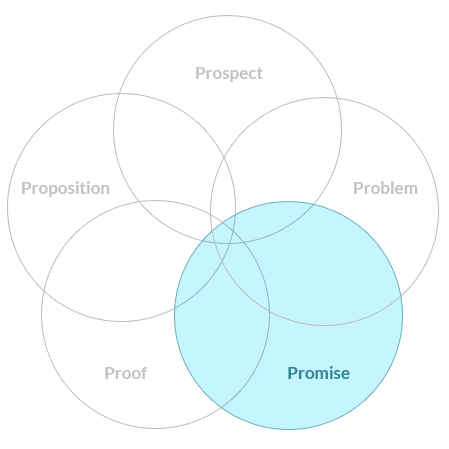
More accurately, the Unique Promise you offer your Ideal Prospect that solves their Core Problem.
Your Unique Promise is a set of benefits. And the key here is to move away from generic “price-of-entry benefits” and toward “point-of-difference benefits”.
“Price of entry” benefits are the benefits you need to PLAY the game – to even be considered a viable option.
“Point-of-difference benefits” are the benefits you need to WIN the game.
Worked Example: Defining Your Unique Benefits
Once Always Be Closing Inc. understands the Core Problems of franchise retailers, they know which “point-of-difference” benefits will win them attention, appointments and contracts.
Here are the key benefits they decide to focus on:
- Specialisation: we specialise in helping floor salespeople improve closing percentages and average transaction size.
- Visibility: we’re the only sales training company to offer a multi-tiered sales dashboard with user permission levels at the store, region and head office levels. This gives you complete visibility of all training activities and outcomes in real time.
- Accountability: we mutually agree on per-store KPIs and we only get paid for stores that show improvement
- Flexible Delivery: we make it easy for every team member to receive training, with a choice of on-site, off-site or online delivery
Only a deep understanding of Core Problems allows you to create Unique Promises that hit your Ideal Prospects’ “buying buttons”.
Lens #4 is Proof:
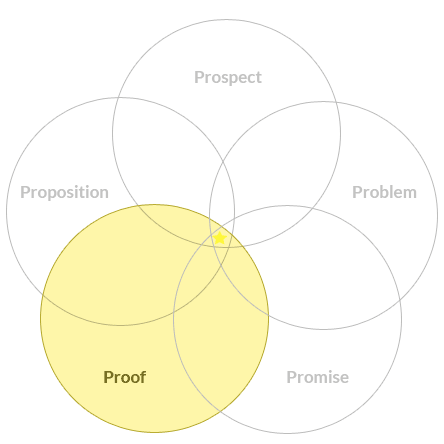
Claims without proof = hype.
Ideal Prospects are typically more educated and discerning than the average prospect. They’ve “seen and heard it all”.
You need Proof in order to cement your claims. Proof elements that support your point-of-difference benefits contribute most powerfully to lead and sale conversion . And “Proof” goes much further than just testimonials. We developed a monster “Cheat Sheet” called 42 Types of Proof for you to download free.
Worked Example: Assembling Comprehensive Proof
Here are some of the main Proof elements that Always Be Closing Inc. decide to use in order to could drive home their unique value proposition to their target market:
- Demonstration: showing their dashboard interface and how easy it is to keep track of an entire franchise organisation
- Performance graphs: showing average per-store gains as a result of previous trainings
- Testimonials: from franchise owners, franchisees and employees that support the buying hot buttons.
- Guarantee: “we only get paid for stores that achieve a sustained sales improvement over at least 90 days”
Remember: proof elements that support your “buying hot buttons” are much more instrumental to making the sale than generic proof elements.
Lens #5 is Proposition:
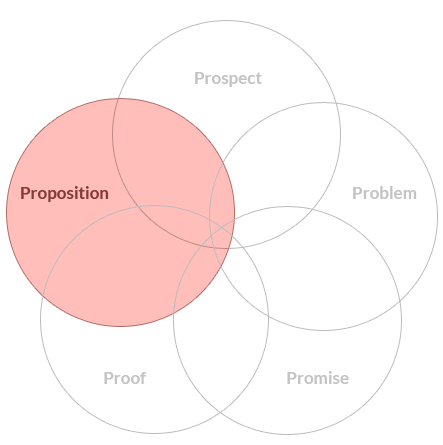
Your Proposition is your offer, or the means by which you invite prospects to engage with you on a commercial basis. Offers must be tested. But a good starting point is to choose an offer that is congruent with your Ideal Prospect and your Conversion Kaleidoscope as a whole.
Worked Example: Formulating an Irresistible Proposition
Always Be Closing Inc. creates a series of offers to appeal to their target market. They test and rotate offers in order to engage with their target market in different ways:
- Offer #1: Free Sales Benchmarking Report: see how your per-store and per-employee sales stack up against the industry as a whole
- Offer #2: Free White Paper: 5 Dangerous Trends Facing Australian Retailers (and How To Avoid Succumbing To Them)
- Offer #3: Pilot Engagement: Increase Per-Employee Sales In 45 Days or Pay Nothing
Just like your Conversion Kaleidoscope as a whole, unique propositions that are different from your competitors gain the most attention, interest and action.
How To Use The Conversion Kaleidoscope To Grow Your Leads and Sales Online
We developed the Conversion Kaleidoscope to solve a problem for our clients, who want to generate a consistent and steady flow of inbound sales leads and ideal clients on the web.
As competition and costs heat up on the web, you need a Unique Value Proposition that cuts through the clutter. Everyone knows that.
But what most people don’t know, is how to develop a Unique Value Proposition.
That’s where the Conversion Kaleidoscope comes in.
Use the process above to create a compelling Unique Value Proposition that will reduce your traffic costs, increase your conversion and boost your margins.
